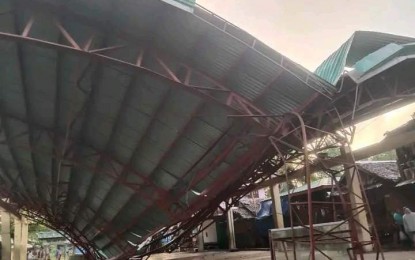
DOWN. The roof of an open multipurpose court in Hinatuan, Surigao del Sur collapses after a magnitude 7.4 earthquake shook the province on Dec. 2, 2023. The Office of Civil Defense on Tuesday (April 23, 2024) cited the need for more engineering intervention to prevent huge death tolls in case of a massive quake in the country. (File photo courtesy of Hinatuan-LGU via PIA-Surigao del Sur)
MANILA – The Office of Civil Defense (OCD) cited the need for more engineering intervention to prevent huge death tolls in case of a massive earthquake in the country.
OCD administrator Undersecretary Ariel Nepomuceno, in a statement Tuesday night, said preparations must go beyond the traditional "Duck, Cover, and Hold" drills to avoid huge casualty figures.
“Indeed, engineering solutions, consistent adherence to the provisions of the National Building Code, and the strict prohibition on construction in areas that are vulnerable to landslides are crucial if we are to prevent the loss of thousands of lives when serious ground-shaking incidents occur in our major cities," he said.
Nepomuceno also called on the government, various sectors, and the entire nation to join forces to make this happen.
“We have identified engineering solutions, among others, as the top defense against killer quakes. Meaning, that the buildings and houses that will be built must conform to the safety standards of our relevant laws and ordinances, which compel designs and construction materials to withstand an 8.3 magnitude challenge. Everyone must demand from their architects and engineers to design and build earthquake-proof structures. Seismic isolators and rollers are available,” he said.
Nepomuceno, meanwhile, said the Philippines could learn a lot from the "resilience culture" of Japan and Taiwan, which were recently hit by strong earthquakes.
"When it comes to their safety from natural calamities, they take everything seriously. They leave no room for mistakes. Rules are automatically followed. Inspections are periodically accomplished," he added.
A series of earthquakes, the strongest of which was magnitude 6.3, struck Taiwan's eastern part from Monday evening until early Tuesday, resulting in the shaking of buildings in the capital Taipei, according to Taiwan's Central Weather Administration.
These tremors occurred just more than two weeks after the April 3 magnitude 7.2 earthquake that hit the island's eastern city of Hualien, the strongest in 25 years.
At about 11:14 p.m. on April 17, a magnitude 6.6 earthquake struck western Japan.
No tsunami warning was issued and there were no immediate reports of major damage or fatal casualties, Kyodo News Agency reported, citing the Japan Meteorological Agency.
The Philippines, as a seismically active country due to its geographical location, experienced 100 destructive earthquakes in the past 400 years.
It is threatened by “many big ones” and many worst-case earthquake scenarios that can happen due to numerous earthquake generators, as explained by the Philippine Institute of Volcanology and Seismology. (PNA)
